Optimizing Your Website for Entity SEO
Entity SEO is a specialized branch of search engine optimization (SEO) that focuses on optimizing the online presence of entities such as people, organizations, and brands.
This article will provide a comprehensive overview of entity SEO, including how to optimize your website for named entity recognition and how to leverage knowledge graphs to improve your search engine rankings.
In today's digital landscape, having a strong online presence is essential for businesses, organizations, and individuals who want to be found by potential customers, clients, or partners. Search engine optimization (SEO) is the process of improving a website's visibility in search engine results, and entity SEO is a specialized branch of SEO that focuses on optimizing the online presence of entities such as people, organizations, and brands.
Entity SEO is important because search engines, such as Google, use advanced algorithms to understand the meaning and context of the words on your website. By optimizing your website for named entities, you can improve your search engine rankings and make it easier for potential customers to find your website.
In this article, we will provide a comprehensive overview of entity SEO, including how to optimize your website for named entity recognition and how to leverage knowledge graphs to improve your search engine rankings.
What is Entity SEO?
Entity SEO is a type of search engine optimization (SEO) that focuses on optimizing individual entities, rather than individual pages, in order to improve a website's visibility and ranking in search engine results pages (SERPs).
An entity is a specific object or concept that can be identified and defined, such as a person, place, or thing. In the context of SEO, entities can include products, services, locations, events, and more.
Entity SEO focuses on identifying and organizing the entities on a website in order to make them more easily discoverable and relevant to search engine algorithms. This involves creating structured data and schema markup for entities, which helps search engines understand the content and context of the website. It also involves creating high-quality content that is relevant and informative for both users and search engines, and optimizing the website's internal linking structure to improve the flow of link equity and enhance the entities' visibility and ranking.
One of the key benefits of Entity SEO is that it helps search engines better understand the relationships between entities on a website, which allows them to deliver more relevant and personalized search results to users.
For example, if a user searches for a specific product, Entity SEO can help ensure that the product appears at the top of the search results, along with other related products, services, and information. This can help improve the user experience and increase the likelihood of a user engaging with the website, which can lead to increased traffic, conversions, and revenue.
Another benefit of Entity SEO is that it can help improve the overall quality and authority of a website. By creating high-quality content and optimizing the website's internal linking structure, Entity SEO can help build trust and credibility with both users and search engines. This can lead to higher rankings for the website and its entities, which can drive more organic traffic and improve the website's overall performance.
Overall, Entity SEO is an important aspect of search engine optimization that can help improve a website's visibility and ranking in search engine results pages. By identifying and organizing entities on a website, creating structured data and schema markup, and creating high-quality content, Entity SEO can help search engines understand the content and context of the website, improve the user experience, and drive more organic traffic and revenue.
What is Named Entity Recognition?
Named entity recognition (NER) is a natural language processing (NLP) technique that helps search engines understand the meaning and context of the words on your website using techniques like part-of-speech tagging.
NER algorithms can identify and classify named entities, such as people, organizations, and locations, in text and use this information to improve search engine results.
- Named entity recognition (NER) is a natural language processing (NLP) technique that is used to identify and classify named entities in text, such as people, organizations, locations, and dates.
- NER can help automate the process of extracting important information from large amounts of text, which can be useful for tasks such as information extraction, sentiment analysis, and document summarization.
- NER systems typically use machine learning algorithms to train on a large annotated corpus of text in order to accurately identify and classify named entities.
- NER can be challenging due to the wide variety of named entities that can appear in text, as well as the complex linguistic patterns and context in which they can appear.
- NER is often used in combination with other NLP techniques, such as part-of-speech tagging and syntactic parsing, in order to improve the accuracy and performance of the system.
What is Named Entity Disambiguation?
Named Entity Disambiguation (NED) is a natural language processing (NLP) technique that involves identifying and disambiguating named entities within a text. Named entities are specific objects or concepts that can be identified and named, such as people, places, and organizations.
Disambiguation refers to the process of determining which entity is being referred to in a given context, as there may be multiple entities with the same name.
For example, if the text mentions "Michael Jordan," it is not immediately clear which entity is being referred to. There could be multiple people named "Michael Jordan," and there could also be a company or organization with that name. In order to accurately identify and understand the text, it is necessary to disambiguate the named entities and determine which specific entity is being referred to.
NED is an important aspect of natural language understanding, as it allows machines to accurately interpret and understand the meaning of text. It is also a valuable tool for many applications, such as information extraction, question answering, and text summarization. By disambiguating named entities, machines can better understand the context and meaning of the text, and can provide more accurate and relevant information and responses.
There are several methods and approaches that can be used for NED, including lexical methods, syntactic parsing methods, and statistical methods.
Lexical methods involve using dictionaries and lexicons to identify named entities and determine their meaning.
Syntactic parsing methods involve analyzing the syntactic structure of the text to identify named entities and their relationships to other words and phrases in the sentence.
Statistical methods involve using machine learning algorithms and large amounts of training data to identify and disambiguate named entities.
Overall, Named Entity Disambiguation is an important natural language processing technique that allows machines to accurately interpret and understand the meaning of text. By disambiguating named entities, machines can provide more accurate and relevant information and responses, which can be valuable for a wide range of applications.
The Role of Knowledge Graphs in Entity SEO
Search engines use knowledge graphs to understand the relationships between named entities via ontology engineering in order to improve the accuracy of search results. A knowledge graph is a database of interconnected entities and their relationships, via semantic triples, and it allows search engines to understand the meaning and context of words on your website in the broader context of the world's knowledge.
For example, if you are a dentist in Los Angeles and your website contains the text "Dr. John Smith is a dentist in Los Angeles," the knowledge graph will understand that "Dr. John Smith" is a person who has the profession of "dentist" and is located in "Los Angeles." This information can then be used by search engines to improve the relevance of your website for search queries related to dentists in Los Angeles.
To leverage the power of knowledge graphs, you should ensure that your website is properly linked to other relevant entities on the web. This can be achieved through backlinking, where other websites link to your website, and co-citation, where your website is mentioned alongside other relevant entities.
Additionally, you can also use structured data, such as schema.org markup, to explicitly specify the relationships between entities on your website and improve the accuracy of knowledge graphs. For example, you can use schema.org markup to specify that "Dr. John Smith" is a person who has the profession of "dentist" and is located in "Los Angeles."
Optimizing Your Website's Content for Entity SEO
To use Entity SEO to optimize a website, the first step is to identify the entities that are most relevant and valuable to the website's content and goals.
This can include products, services, locations, events, and more. Once the entities have been identified, the next step is to create structured data and schema markup for each entity, which will help search engines understand the content and context of the website. This can be done using tools such as JSON-LD or Microdata.
Next, it is important to create high-quality content that is relevant and informative for both users and search engines. This content should be organized and structured in a way that supports the entities and their relationships to each other. One effective way to do this is to use topic clusters, which are groups of related content that revolve around a specific entity or concept. For example, if the website sells furniture, a topic cluster could be created for each type of furniture, such as chairs, tables, and sofas.
Once the content has been created, the next step is to optimize the website's internal linking structure to improve the flow of link equity and enhance the entities' visibility and ranking. This can be done by linking to relevant entities within the content, as well as linking between the different pages and posts on the website. This will help search engines understand the relationships between the entities and the content, and will also make it easier for users to navigate the website and find the information they are looking for.
In addition to these steps, it is also important to monitor and analyze the website's performance to identify any areas for improvement. This can be done using tools such as Google Analytics and Search Console, which can provide insights into the website's traffic, ranking, and user behavior. By regularly monitoring and analyzing the website's performance, it is possible to identify any issues or opportunities for optimization, and to make adjustments and improvements as needed.
Overall, Entity SEO is an effective way to optimize a website and improve its visibility and ranking in search engine results pages. By identifying and organizing entities, creating structured data and schema markup, creating high-quality content, and optimizing the website's internal linking structure, it is possible to improve the website's performance and drive more organic traffic and revenue. By incorporating topic clusters into the content strategy, it is also possible to create a more organized and user-friendly website that is better able to meet the needs of both users and search engines.
The Importance of Entity SEO for Online Visibility
The importance of Entity SEO lies in its ability to improve a website's online visibility and performance. By identifying and organizing the entities on a website, Entity SEO can help search engines better understand the content and context of the website, which allows them to deliver more relevant and personalized search results to users. This can improve the user experience and increase the likelihood of a user engaging with the website, which can lead to increased traffic, conversions, and revenue.
In addition, Entity SEO can help improve the overall quality and authority of a website. By creating high-quality content and optimizing the website's internal linking structure, Entity SEO can help build trust and credibility with both users and search engines. This can lead to higher rankings for the website and its entities, which can drive more organic traffic and improve the website's overall performance.
Furthermore, Entity SEO is important for staying ahead of the competition in today's digital landscape. With more and more businesses turning to the internet to reach customers and generate revenue, the competition for visibility and ranking in search engine results pages is fierce. By implementing Entity SEO, a website can gain a competitive advantage and increase its chances of standing out from the competition.
Overall, Entity SEO is an essential component of any successful online marketing strategy. By identifying and organizing entities on a website, creating high-quality content, and optimizing the website's internal linking structure, Entity SEO can help improve a website's online visibility and performance, build trust and credibility, and gain a competitive advantage. By investing in Entity SEO, businesses can increase their chances of success in the digital world and reach their target audience more effectively.
Entity SEO in Market Brew
Market Brew's featured Entity SEO algorithms are called Spotlight and Spotlight Focus.
Note: these are entity-based semantic algorithms. Embedding-based algorithms for classifying content have been steadily gaining the focus of Google's bias in most search engine result pages (SERP). A mixture of multiple approaches is always present.
They make up semantic algorithm arc of four distinct approaches to classifying content.
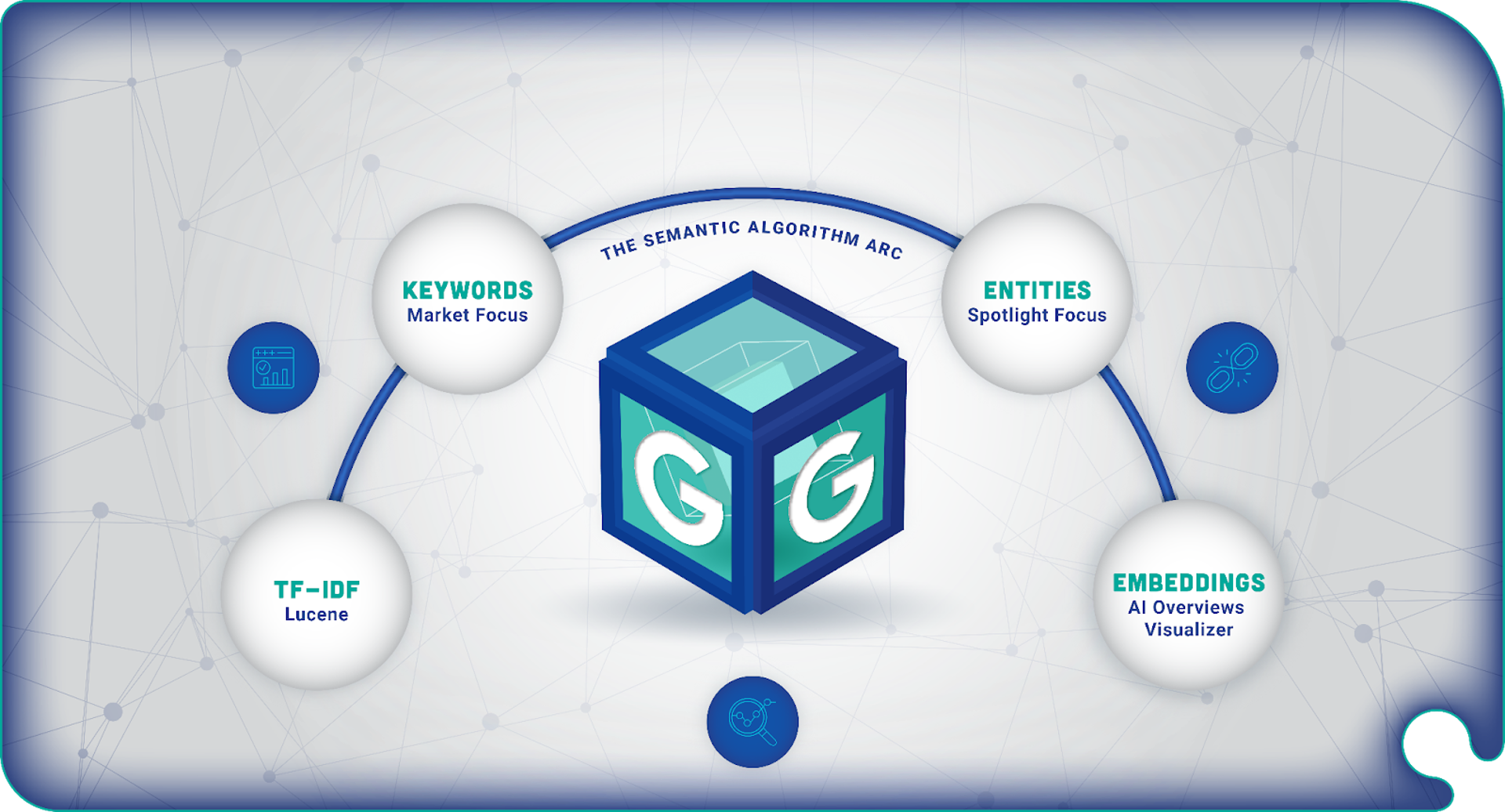
View our FREE Search Engine Visualizers for both Entities and Embeddings!
- the Spotlight Visualizer to see an example of how search engines see entities
- the AI Overviews Visualizer to see an example of how search engines see embeddings
Spotlight allows users to see exactly how each page is processed against the knowledge graph to perform named entity extraction, named resolution, and named entity disambiguation.
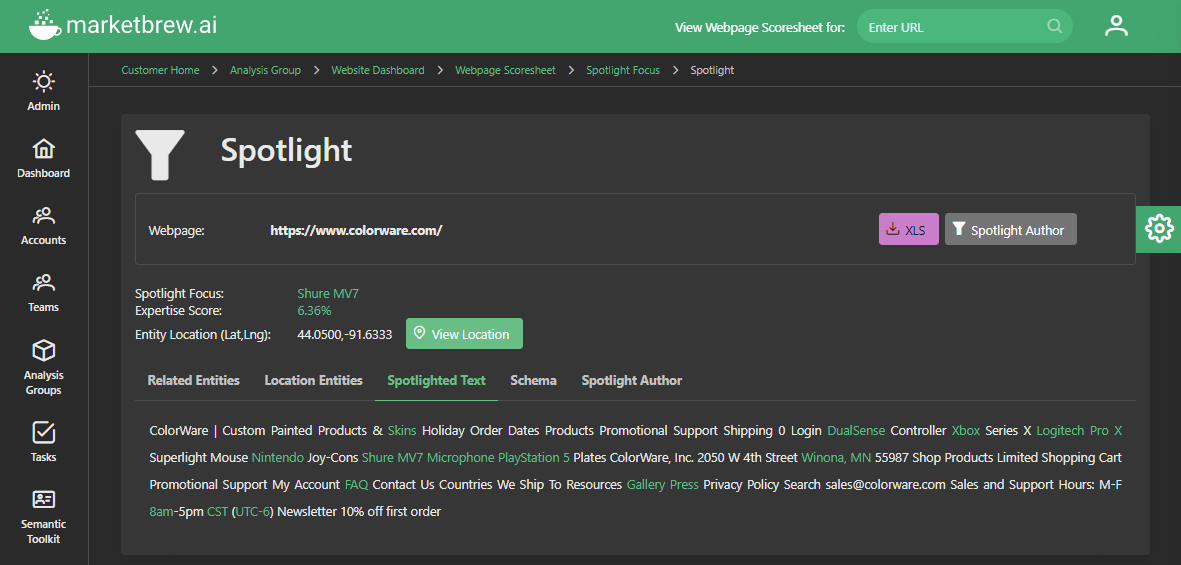
By viewing the Spotlighted Text tab, users can be confident that a search engine is seeing the entities on the page the way they were intended by the author.
If there are Location Entities that have been detected, they will be found on the tab bearing that same name, and a latitude / longitude centroid will be created based on the locations found.
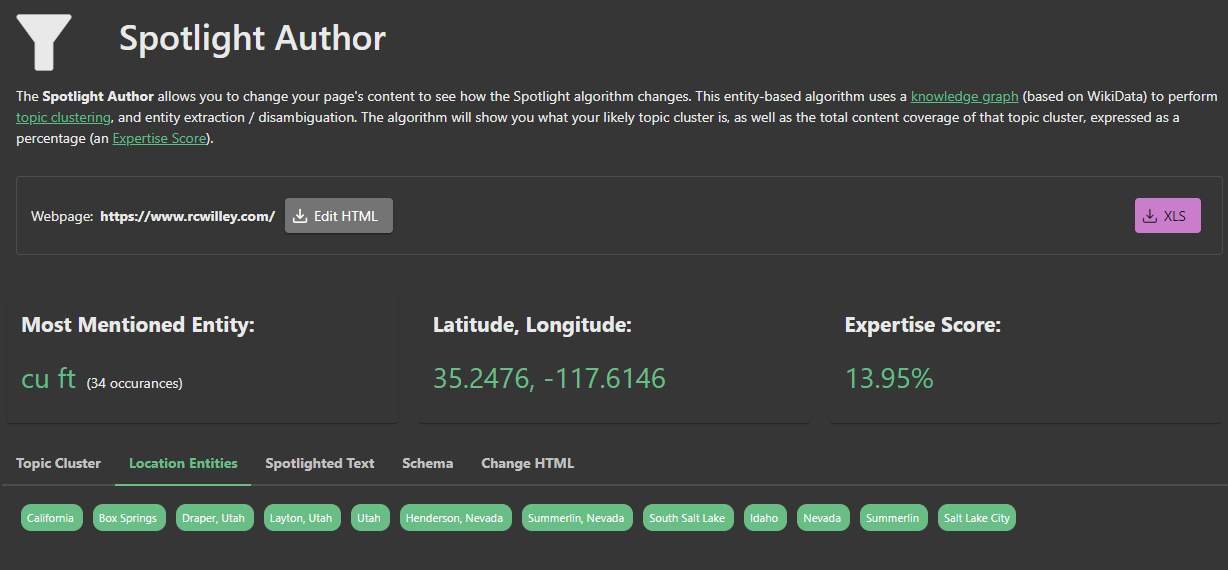
A Location Entity algorithm can determine how far the page's location centroid is to the query terms. For instance, a search for "Shure MV7 in Winona, MN" will return high relevancy for the Location algorithm; whereas "Sure MV7 in New York" will not.
Market Brew uses the Spotlight algorithm to generate a topic cluster that are essentially related entities on the page.
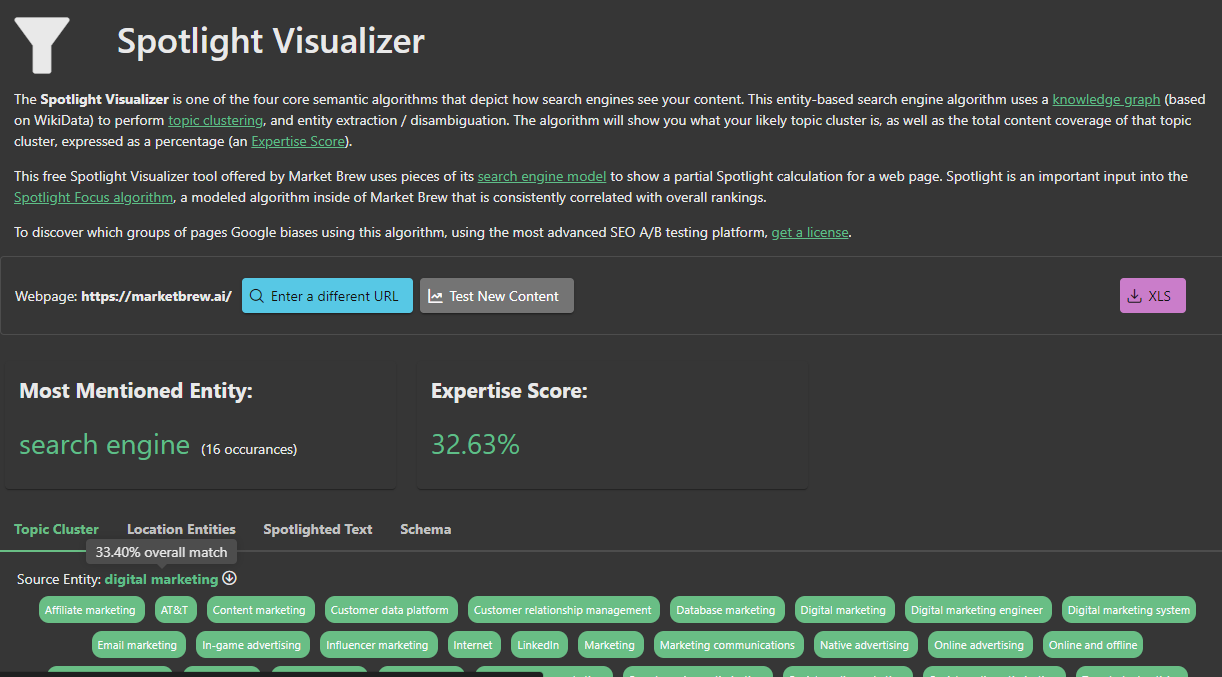
These related entities are also used in a more sophisticated classifier algorithm called the Spotlight Focus algorithm.
Spotlight Focus takes the topic cluster or related entities, and pairs them with an accurate link graph to extract the meaning of each page.
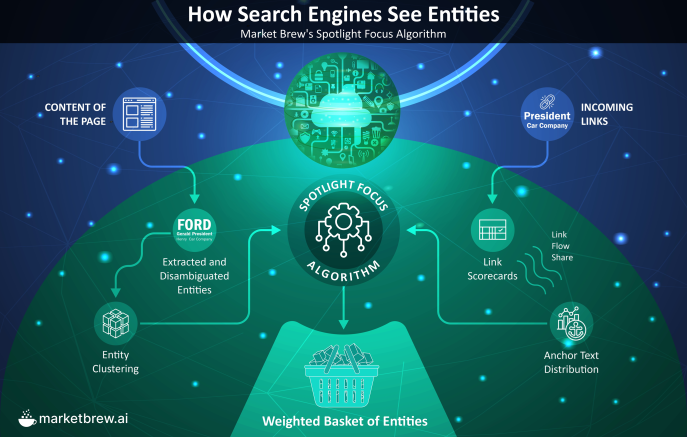
Each entity will have a relative weighting / rank and a basket of entities will be generated and attached to each page.
When a query is evaluated against the search engine model, one of the semantic algorithms that is used is the Spotlight Focus.
Depending on how well the query matches the basket of entities, the Spotlight Focus score can go up or down.
You may also like
Guides & Videos
AI - Driven Insights
Guides & Videos
SEO Forecasting Increasing Your Chances Of Success
History


